Qube Logistics Network in NSW: Analysis, Strategies, and Solutions
VerifiedAdded on 2023/06/08
|12
|3292
|153
Report
AI Summary
This report provides a comprehensive analysis of Qube Logistics, a major player in the Australian logistics market, focusing on its operations in New South Wales (NSW). It begins with an introduction to Qube Logistics, outlining its services and its significant role in the Australian export/import sector. The report then delves into the specific features of Qube Logistics in NSW, highlighting its key terminals and services. A significant portion of the report is dedicated to identifying the problems faced by Qube's logistics network, including issues related to multi-modal transport access, conflicts with inland depots, asset privatization, commodity market downturns, and weather conditions. The report then explores various logistics management strategies that can be employed to solve these problems, such as logistics collaboration, rolling horizon approaches, reverse logistics, and strategies to address limited capacity. The report also discusses the steps the government should take to assist in resolving these issues and concludes with recommendations for Qube Logistics to improve its efficiency and profitability. The analysis is supported by academic journal articles and the report follows the requested format.

Qube Logistics
1
1
Paraphrase This Document
Need a fresh take? Get an instant paraphrase of this document with our AI Paraphraser
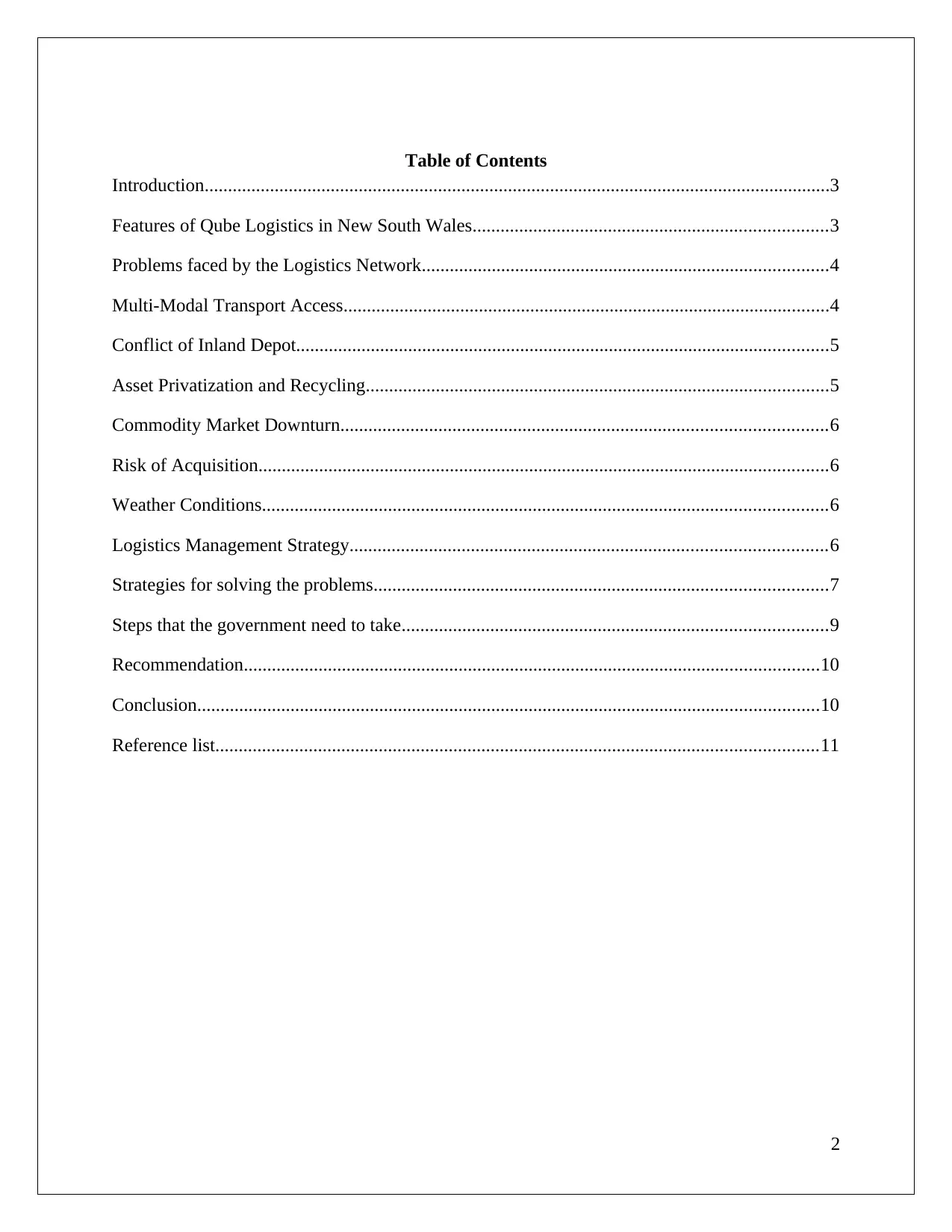
Table of Contents
Introduction......................................................................................................................................3
Features of Qube Logistics in New South Wales............................................................................3
Problems faced by the Logistics Network.......................................................................................4
Multi-Modal Transport Access........................................................................................................4
Conflict of Inland Depot..................................................................................................................5
Asset Privatization and Recycling...................................................................................................5
Commodity Market Downturn........................................................................................................6
Risk of Acquisition..........................................................................................................................6
Weather Conditions.........................................................................................................................6
Logistics Management Strategy......................................................................................................6
Strategies for solving the problems.................................................................................................7
Steps that the government need to take...........................................................................................9
Recommendation...........................................................................................................................10
Conclusion.....................................................................................................................................10
Reference list.................................................................................................................................11
2
Introduction......................................................................................................................................3
Features of Qube Logistics in New South Wales............................................................................3
Problems faced by the Logistics Network.......................................................................................4
Multi-Modal Transport Access........................................................................................................4
Conflict of Inland Depot..................................................................................................................5
Asset Privatization and Recycling...................................................................................................5
Commodity Market Downturn........................................................................................................6
Risk of Acquisition..........................................................................................................................6
Weather Conditions.........................................................................................................................6
Logistics Management Strategy......................................................................................................6
Strategies for solving the problems.................................................................................................7
Steps that the government need to take...........................................................................................9
Recommendation...........................................................................................................................10
Conclusion.....................................................................................................................................10
Reference list.................................................................................................................................11
2
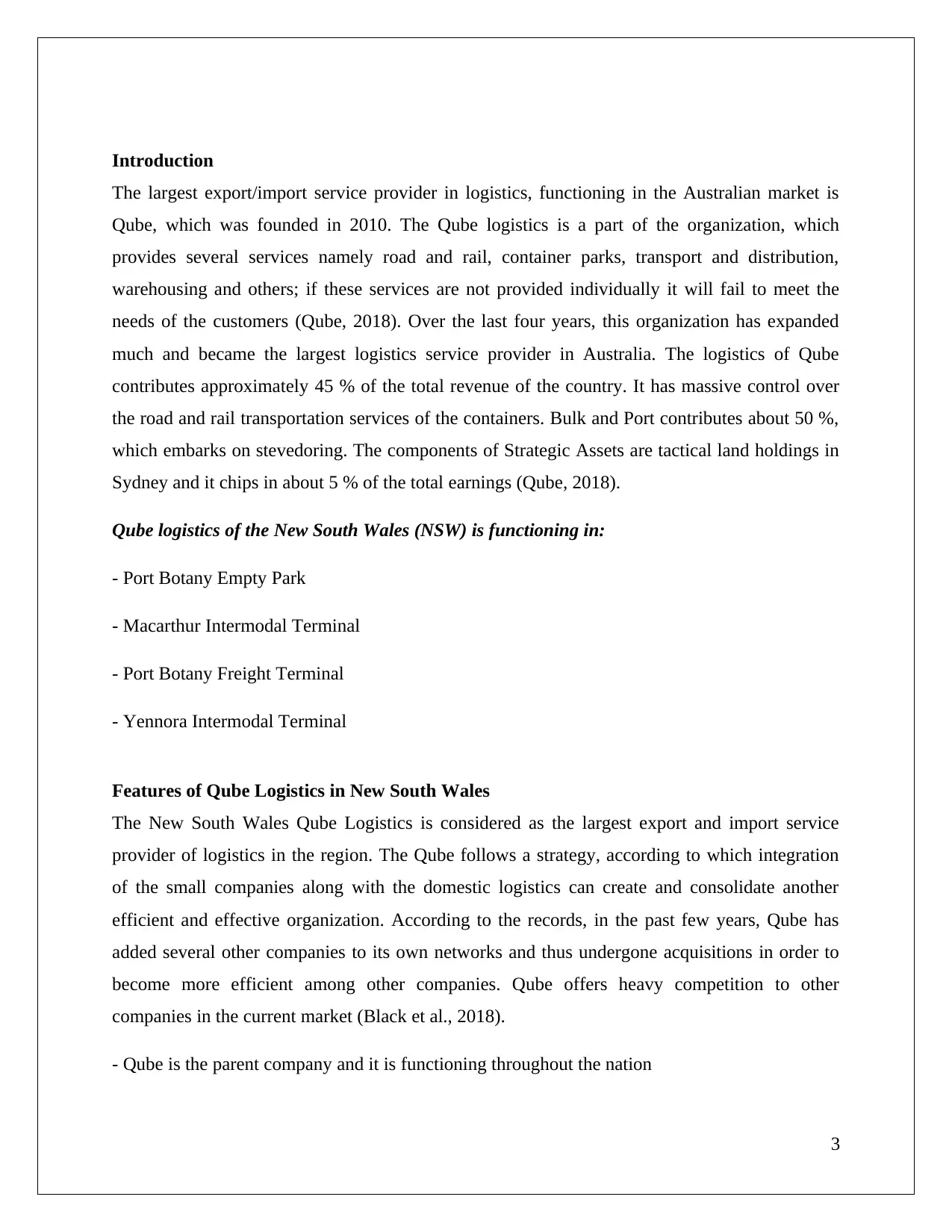
Introduction
The largest export/import service provider in logistics, functioning in the Australian market is
Qube, which was founded in 2010. The Qube logistics is a part of the organization, which
provides several services namely road and rail, container parks, transport and distribution,
warehousing and others; if these services are not provided individually it will fail to meet the
needs of the customers (Qube, 2018). Over the last four years, this organization has expanded
much and became the largest logistics service provider in Australia. The logistics of Qube
contributes approximately 45 % of the total revenue of the country. It has massive control over
the road and rail transportation services of the containers. Bulk and Port contributes about 50 %,
which embarks on stevedoring. The components of Strategic Assets are tactical land holdings in
Sydney and it chips in about 5 % of the total earnings (Qube, 2018).
Qube logistics of the New South Wales (NSW) is functioning in:
- Port Botany Empty Park
- Macarthur Intermodal Terminal
- Port Botany Freight Terminal
- Yennora Intermodal Terminal
Features of Qube Logistics in New South Wales
The New South Wales Qube Logistics is considered as the largest export and import service
provider of logistics in the region. The Qube follows a strategy, according to which integration
of the small companies along with the domestic logistics can create and consolidate another
efficient and effective organization. According to the records, in the past few years, Qube has
added several other companies to its own networks and thus undergone acquisitions in order to
become more efficient among other companies. Qube offers heavy competition to other
companies in the current market (Black et al., 2018).
- Qube is the parent company and it is functioning throughout the nation
3
The largest export/import service provider in logistics, functioning in the Australian market is
Qube, which was founded in 2010. The Qube logistics is a part of the organization, which
provides several services namely road and rail, container parks, transport and distribution,
warehousing and others; if these services are not provided individually it will fail to meet the
needs of the customers (Qube, 2018). Over the last four years, this organization has expanded
much and became the largest logistics service provider in Australia. The logistics of Qube
contributes approximately 45 % of the total revenue of the country. It has massive control over
the road and rail transportation services of the containers. Bulk and Port contributes about 50 %,
which embarks on stevedoring. The components of Strategic Assets are tactical land holdings in
Sydney and it chips in about 5 % of the total earnings (Qube, 2018).
Qube logistics of the New South Wales (NSW) is functioning in:
- Port Botany Empty Park
- Macarthur Intermodal Terminal
- Port Botany Freight Terminal
- Yennora Intermodal Terminal
Features of Qube Logistics in New South Wales
The New South Wales Qube Logistics is considered as the largest export and import service
provider of logistics in the region. The Qube follows a strategy, according to which integration
of the small companies along with the domestic logistics can create and consolidate another
efficient and effective organization. According to the records, in the past few years, Qube has
added several other companies to its own networks and thus undergone acquisitions in order to
become more efficient among other companies. Qube offers heavy competition to other
companies in the current market (Black et al., 2018).
- Qube is the parent company and it is functioning throughout the nation
3
⊘ This is a preview!⊘
Do you want full access?
Subscribe today to unlock all pages.

Trusted by 1+ million students worldwide
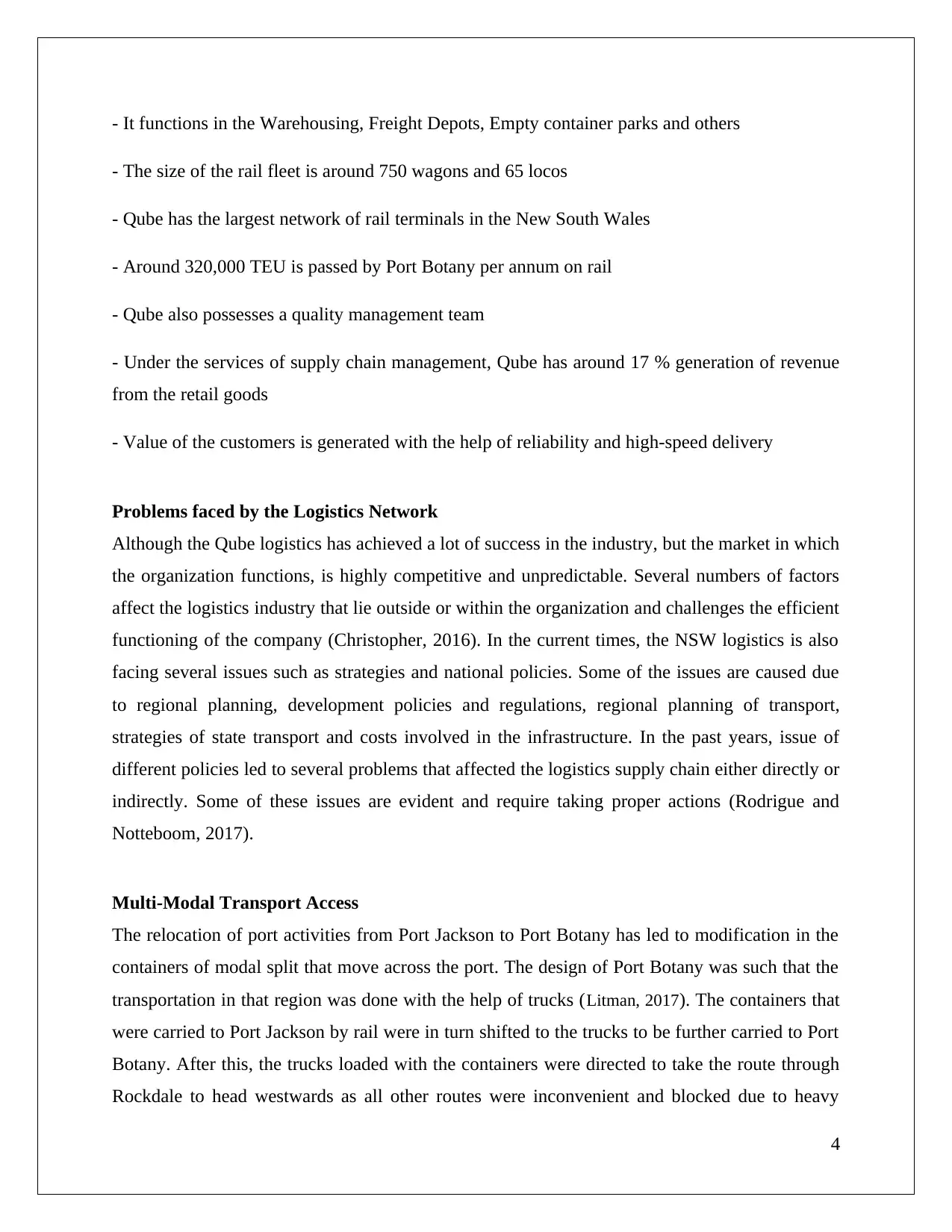
- It functions in the Warehousing, Freight Depots, Empty container parks and others
- The size of the rail fleet is around 750 wagons and 65 locos
- Qube has the largest network of rail terminals in the New South Wales
- Around 320,000 TEU is passed by Port Botany per annum on rail
- Qube also possesses a quality management team
- Under the services of supply chain management, Qube has around 17 % generation of revenue
from the retail goods
- Value of the customers is generated with the help of reliability and high-speed delivery
Problems faced by the Logistics Network
Although the Qube logistics has achieved a lot of success in the industry, but the market in which
the organization functions, is highly competitive and unpredictable. Several numbers of factors
affect the logistics industry that lie outside or within the organization and challenges the efficient
functioning of the company (Christopher, 2016). In the current times, the NSW logistics is also
facing several issues such as strategies and national policies. Some of the issues are caused due
to regional planning, development policies and regulations, regional planning of transport,
strategies of state transport and costs involved in the infrastructure. In the past years, issue of
different policies led to several problems that affected the logistics supply chain either directly or
indirectly. Some of these issues are evident and require taking proper actions (Rodrigue and
Notteboom, 2017).
Multi-Modal Transport Access
The relocation of port activities from Port Jackson to Port Botany has led to modification in the
containers of modal split that move across the port. The design of Port Botany was such that the
transportation in that region was done with the help of trucks (Litman, 2017). The containers that
were carried to Port Jackson by rail were in turn shifted to the trucks to be further carried to Port
Botany. After this, the trucks loaded with the containers were directed to take the route through
Rockdale to head westwards as all other routes were inconvenient and blocked due to heavy
4
- The size of the rail fleet is around 750 wagons and 65 locos
- Qube has the largest network of rail terminals in the New South Wales
- Around 320,000 TEU is passed by Port Botany per annum on rail
- Qube also possesses a quality management team
- Under the services of supply chain management, Qube has around 17 % generation of revenue
from the retail goods
- Value of the customers is generated with the help of reliability and high-speed delivery
Problems faced by the Logistics Network
Although the Qube logistics has achieved a lot of success in the industry, but the market in which
the organization functions, is highly competitive and unpredictable. Several numbers of factors
affect the logistics industry that lie outside or within the organization and challenges the efficient
functioning of the company (Christopher, 2016). In the current times, the NSW logistics is also
facing several issues such as strategies and national policies. Some of the issues are caused due
to regional planning, development policies and regulations, regional planning of transport,
strategies of state transport and costs involved in the infrastructure. In the past years, issue of
different policies led to several problems that affected the logistics supply chain either directly or
indirectly. Some of these issues are evident and require taking proper actions (Rodrigue and
Notteboom, 2017).
Multi-Modal Transport Access
The relocation of port activities from Port Jackson to Port Botany has led to modification in the
containers of modal split that move across the port. The design of Port Botany was such that the
transportation in that region was done with the help of trucks (Litman, 2017). The containers that
were carried to Port Jackson by rail were in turn shifted to the trucks to be further carried to Port
Botany. After this, the trucks loaded with the containers were directed to take the route through
Rockdale to head westwards as all other routes were inconvenient and blocked due to heavy
4
Paraphrase This Document
Need a fresh take? Get an instant paraphrase of this document with our AI Paraphraser

traffic (Dony et al., 2015). The export and import companies had many conflicts based on the
topic that the trucks loaded with the containers must not harm the environment by violating the
environmental rules otherwise the alternative sources will be kept closed for the operations. The
council of local government denied using the roads that were newly constructed for the freight
transfers and preferred using rail networks. The authority of state retail, later allowed around 70
% transfer of the containers through rail networks by specified routes. This rule was also further
modified and passed in 2011 that allowed the passing of 20 % of the containers by rail through
Port Botany.
Conflict of Inland Depot
In the industrial area, about 60-hectere of area is left unused that is connected to Port Botany via
rail. In the upcoming years, the area is going to face many developments that will lead to its
conversion into an intermodal facility. The announcement of development of this area by the
state government gave rise to a conflict with the local government (Black et al., 2018).
Limited storage of the containers and less space in the terminal
The intermodal boundary in a logistics network is known as a terminal. Handling the containers
play a vital role in keeping track of the shipping records as well as in reduction of costs. It plays
an important part of the temporary space of storage and is considered as a hub point for the
containers. Limited storage space in the containers and the terminals can be a problem in the near
future as the demand is increasing daily (Roso et al, 2017).
Asset Privatization and Recycling
Australia’s second largest container port is Port Botany. The NSW Port Consortium has the lease
of this port. This idea of privatization is an asset recycling initiative taken up by the government
of Australia (Roso et al., 2015). The construction of lines for better operation was advised by this
transaction and gave rise to conflicts. The purpose of the plan was to construct a tunnel between
Rozelle and St. Peters in order to release the congestion on the network that already exists
(HEAD, 2016). After the completion of the NSW state elections, the ruling government changed,
this led to many changes in the plan. A hot topic of the elections was lack of funding. Therefore,
5
topic that the trucks loaded with the containers must not harm the environment by violating the
environmental rules otherwise the alternative sources will be kept closed for the operations. The
council of local government denied using the roads that were newly constructed for the freight
transfers and preferred using rail networks. The authority of state retail, later allowed around 70
% transfer of the containers through rail networks by specified routes. This rule was also further
modified and passed in 2011 that allowed the passing of 20 % of the containers by rail through
Port Botany.
Conflict of Inland Depot
In the industrial area, about 60-hectere of area is left unused that is connected to Port Botany via
rail. In the upcoming years, the area is going to face many developments that will lead to its
conversion into an intermodal facility. The announcement of development of this area by the
state government gave rise to a conflict with the local government (Black et al., 2018).
Limited storage of the containers and less space in the terminal
The intermodal boundary in a logistics network is known as a terminal. Handling the containers
play a vital role in keeping track of the shipping records as well as in reduction of costs. It plays
an important part of the temporary space of storage and is considered as a hub point for the
containers. Limited storage space in the containers and the terminals can be a problem in the near
future as the demand is increasing daily (Roso et al, 2017).
Asset Privatization and Recycling
Australia’s second largest container port is Port Botany. The NSW Port Consortium has the lease
of this port. This idea of privatization is an asset recycling initiative taken up by the government
of Australia (Roso et al., 2015). The construction of lines for better operation was advised by this
transaction and gave rise to conflicts. The purpose of the plan was to construct a tunnel between
Rozelle and St. Peters in order to release the congestion on the network that already exists
(HEAD, 2016). After the completion of the NSW state elections, the ruling government changed,
this led to many changes in the plan. A hot topic of the elections was lack of funding. Therefore,
5

the entire plan led to division in the parties and later the outcome of this was introduction of toll
tax. The plan is under process till the present times.
Commodity Market Downturn
To the market of commodity rail transport, Qube is entirely new. In order to make its position in
the market, the services provided by Qube needs to be of very high quality. However, the
functioning of Qube can be largely affected by the current downturn in commodity market
(Storey, 2016). The earnings and contracts as not being able to cover the costs involved as the
demand for iron ore and coal is quite low. The growth of the marginal mines can be affected by
the low prices of the commodities that are constant. Junior mines needs to be considered by
Qube in order to survive in the competitive market.
Risk of Acquisition
Qube has developed to be the largest logistics service provider and is constantly growing since
the past few years. It has undergone some acquisitions and the credit of its growth can be given
to that. However, some of the acquisitions are based on several tough integrations and
unfavourably affected Qube (Mescall and Klassen, 2018.). The plan of the company to mine
more synergies, weakened the transactions specifically in short term, which may not be able to
provide a desired outcome on time.
Weather Conditions
Adverse weather condition is one of the factors that largely affected the logistics activities.
Although the logistic systems and the transportation services are designed such that they can
withstand all kinds of unpleasant climate and weather conditions, some extreme situations such
as snowfall, high temperatures and heat waves may lead to slowing down of the process of
transportation (Shafiee, 2015). The lanes of shipping often experience sea level falls and rises
that may affect the ships. Expansion of the rail tracks and flattening of the tires may be caused
because of high temperatures and this increases accident risks. The harbour facilities and the
coastal infrastructures are also affected by the adverse weather conditions.
6
tax. The plan is under process till the present times.
Commodity Market Downturn
To the market of commodity rail transport, Qube is entirely new. In order to make its position in
the market, the services provided by Qube needs to be of very high quality. However, the
functioning of Qube can be largely affected by the current downturn in commodity market
(Storey, 2016). The earnings and contracts as not being able to cover the costs involved as the
demand for iron ore and coal is quite low. The growth of the marginal mines can be affected by
the low prices of the commodities that are constant. Junior mines needs to be considered by
Qube in order to survive in the competitive market.
Risk of Acquisition
Qube has developed to be the largest logistics service provider and is constantly growing since
the past few years. It has undergone some acquisitions and the credit of its growth can be given
to that. However, some of the acquisitions are based on several tough integrations and
unfavourably affected Qube (Mescall and Klassen, 2018.). The plan of the company to mine
more synergies, weakened the transactions specifically in short term, which may not be able to
provide a desired outcome on time.
Weather Conditions
Adverse weather condition is one of the factors that largely affected the logistics activities.
Although the logistic systems and the transportation services are designed such that they can
withstand all kinds of unpleasant climate and weather conditions, some extreme situations such
as snowfall, high temperatures and heat waves may lead to slowing down of the process of
transportation (Shafiee, 2015). The lanes of shipping often experience sea level falls and rises
that may affect the ships. Expansion of the rail tracks and flattening of the tires may be caused
because of high temperatures and this increases accident risks. The harbour facilities and the
coastal infrastructures are also affected by the adverse weather conditions.
6
⊘ This is a preview!⊘
Do you want full access?
Subscribe today to unlock all pages.

Trusted by 1+ million students worldwide
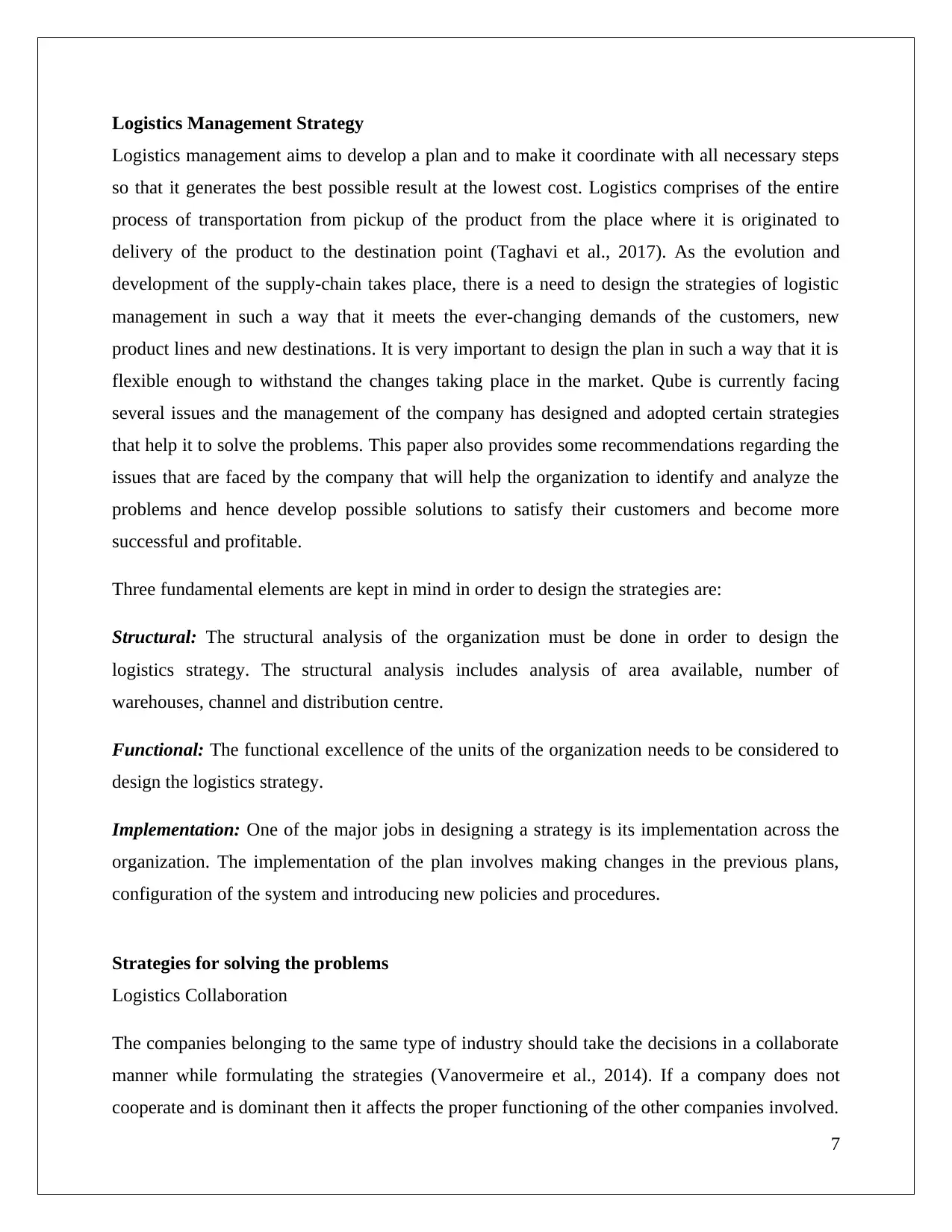
Logistics Management Strategy
Logistics management aims to develop a plan and to make it coordinate with all necessary steps
so that it generates the best possible result at the lowest cost. Logistics comprises of the entire
process of transportation from pickup of the product from the place where it is originated to
delivery of the product to the destination point (Taghavi et al., 2017). As the evolution and
development of the supply-chain takes place, there is a need to design the strategies of logistic
management in such a way that it meets the ever-changing demands of the customers, new
product lines and new destinations. It is very important to design the plan in such a way that it is
flexible enough to withstand the changes taking place in the market. Qube is currently facing
several issues and the management of the company has designed and adopted certain strategies
that help it to solve the problems. This paper also provides some recommendations regarding the
issues that are faced by the company that will help the organization to identify and analyze the
problems and hence develop possible solutions to satisfy their customers and become more
successful and profitable.
Three fundamental elements are kept in mind in order to design the strategies are:
Structural: The structural analysis of the organization must be done in order to design the
logistics strategy. The structural analysis includes analysis of area available, number of
warehouses, channel and distribution centre.
Functional: The functional excellence of the units of the organization needs to be considered to
design the logistics strategy.
Implementation: One of the major jobs in designing a strategy is its implementation across the
organization. The implementation of the plan involves making changes in the previous plans,
configuration of the system and introducing new policies and procedures.
Strategies for solving the problems
Logistics Collaboration
The companies belonging to the same type of industry should take the decisions in a collaborate
manner while formulating the strategies (Vanovermeire et al., 2014). If a company does not
cooperate and is dominant then it affects the proper functioning of the other companies involved.
7
Logistics management aims to develop a plan and to make it coordinate with all necessary steps
so that it generates the best possible result at the lowest cost. Logistics comprises of the entire
process of transportation from pickup of the product from the place where it is originated to
delivery of the product to the destination point (Taghavi et al., 2017). As the evolution and
development of the supply-chain takes place, there is a need to design the strategies of logistic
management in such a way that it meets the ever-changing demands of the customers, new
product lines and new destinations. It is very important to design the plan in such a way that it is
flexible enough to withstand the changes taking place in the market. Qube is currently facing
several issues and the management of the company has designed and adopted certain strategies
that help it to solve the problems. This paper also provides some recommendations regarding the
issues that are faced by the company that will help the organization to identify and analyze the
problems and hence develop possible solutions to satisfy their customers and become more
successful and profitable.
Three fundamental elements are kept in mind in order to design the strategies are:
Structural: The structural analysis of the organization must be done in order to design the
logistics strategy. The structural analysis includes analysis of area available, number of
warehouses, channel and distribution centre.
Functional: The functional excellence of the units of the organization needs to be considered to
design the logistics strategy.
Implementation: One of the major jobs in designing a strategy is its implementation across the
organization. The implementation of the plan involves making changes in the previous plans,
configuration of the system and introducing new policies and procedures.
Strategies for solving the problems
Logistics Collaboration
The companies belonging to the same type of industry should take the decisions in a collaborate
manner while formulating the strategies (Vanovermeire et al., 2014). If a company does not
cooperate and is dominant then it affects the proper functioning of the other companies involved.
7
Paraphrase This Document
Need a fresh take? Get an instant paraphrase of this document with our AI Paraphraser

This is not a good approach for the businesses. A logistics alliance must be formed in order to
fight any kinds of issues.
Rolling Horizon Approach
The rolling horizon approach can be applied to solve the issue of less amount of space in the
containers, in the areas, which have to deal with a large number of containers. for this reason,
time of leaving of the containers needs to be noted and space should be allocated in order to
balance the workload.
Reverse Logistics
The method that deals with products that users do not require anymore or the products that are
unusable is reverse logistics. This process functions to reuse the products or materials or to move
them from their destination to capture value. The four things essential for reverse logistics are:
- Reduction
- Substitution
- Reuse
- Recycle
Reverse logistics is divided into three fields according to the quantitative model:
- Distribution planning
- Inventory control
- Production planning
Both the forward and return networks can be considered to design a nonlinear model.
Limited Capacity
This phenomenon can be used in case there is lack of sufficient trucks, machineries, warehouse
space or drivers. In this strategy, the empty vehicles should be allowed to be used while returning
to save cost.
8
fight any kinds of issues.
Rolling Horizon Approach
The rolling horizon approach can be applied to solve the issue of less amount of space in the
containers, in the areas, which have to deal with a large number of containers. for this reason,
time of leaving of the containers needs to be noted and space should be allocated in order to
balance the workload.
Reverse Logistics
The method that deals with products that users do not require anymore or the products that are
unusable is reverse logistics. This process functions to reuse the products or materials or to move
them from their destination to capture value. The four things essential for reverse logistics are:
- Reduction
- Substitution
- Reuse
- Recycle
Reverse logistics is divided into three fields according to the quantitative model:
- Distribution planning
- Inventory control
- Production planning
Both the forward and return networks can be considered to design a nonlinear model.
Limited Capacity
This phenomenon can be used in case there is lack of sufficient trucks, machineries, warehouse
space or drivers. In this strategy, the empty vehicles should be allowed to be used while returning
to save cost.
8
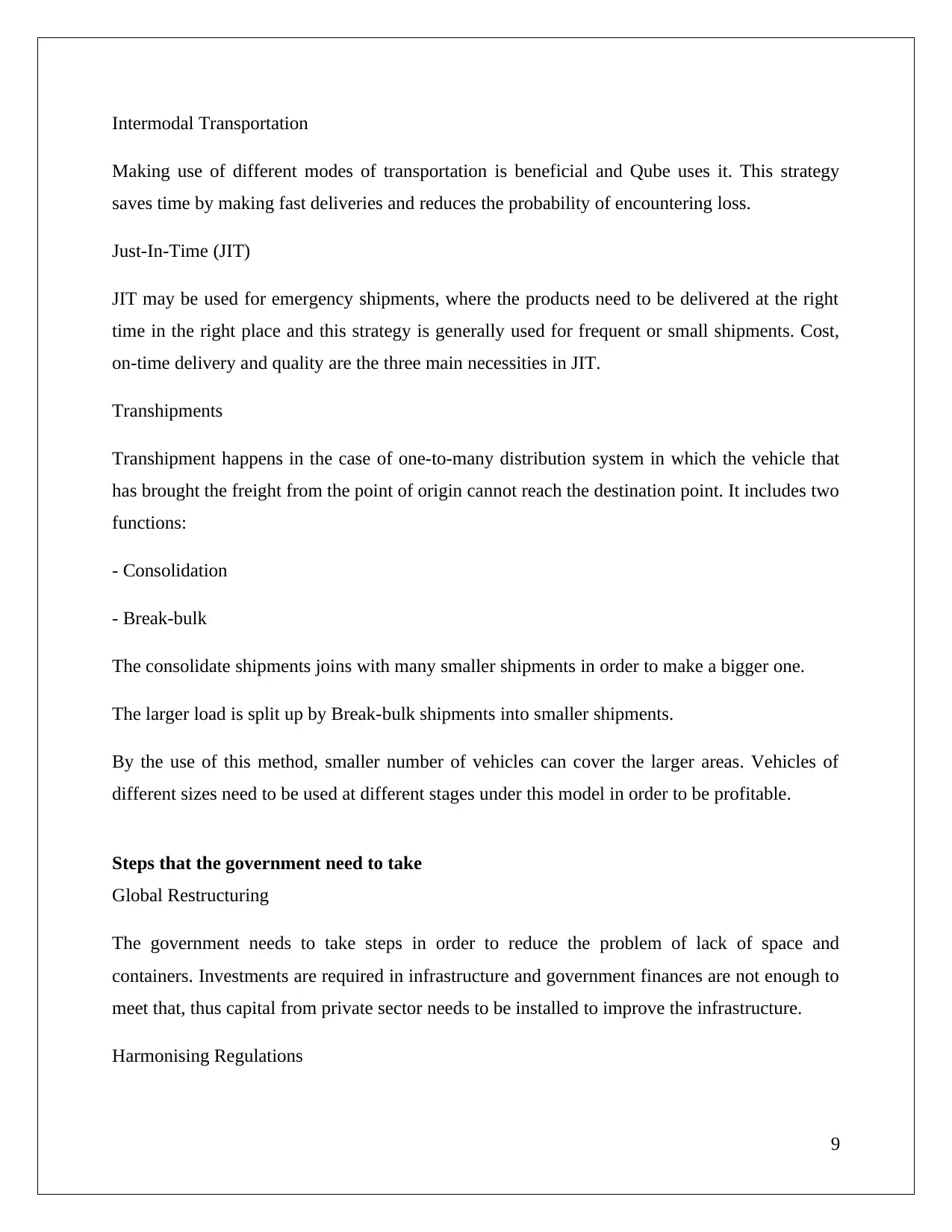
Intermodal Transportation
Making use of different modes of transportation is beneficial and Qube uses it. This strategy
saves time by making fast deliveries and reduces the probability of encountering loss.
Just-In-Time (JIT)
JIT may be used for emergency shipments, where the products need to be delivered at the right
time in the right place and this strategy is generally used for frequent or small shipments. Cost,
on-time delivery and quality are the three main necessities in JIT.
Transhipments
Transhipment happens in the case of one-to-many distribution system in which the vehicle that
has brought the freight from the point of origin cannot reach the destination point. It includes two
functions:
- Consolidation
- Break-bulk
The consolidate shipments joins with many smaller shipments in order to make a bigger one.
The larger load is split up by Break-bulk shipments into smaller shipments.
By the use of this method, smaller number of vehicles can cover the larger areas. Vehicles of
different sizes need to be used at different stages under this model in order to be profitable.
Steps that the government need to take
Global Restructuring
The government needs to take steps in order to reduce the problem of lack of space and
containers. Investments are required in infrastructure and government finances are not enough to
meet that, thus capital from private sector needs to be installed to improve the infrastructure.
Harmonising Regulations
9
Making use of different modes of transportation is beneficial and Qube uses it. This strategy
saves time by making fast deliveries and reduces the probability of encountering loss.
Just-In-Time (JIT)
JIT may be used for emergency shipments, where the products need to be delivered at the right
time in the right place and this strategy is generally used for frequent or small shipments. Cost,
on-time delivery and quality are the three main necessities in JIT.
Transhipments
Transhipment happens in the case of one-to-many distribution system in which the vehicle that
has brought the freight from the point of origin cannot reach the destination point. It includes two
functions:
- Consolidation
- Break-bulk
The consolidate shipments joins with many smaller shipments in order to make a bigger one.
The larger load is split up by Break-bulk shipments into smaller shipments.
By the use of this method, smaller number of vehicles can cover the larger areas. Vehicles of
different sizes need to be used at different stages under this model in order to be profitable.
Steps that the government need to take
Global Restructuring
The government needs to take steps in order to reduce the problem of lack of space and
containers. Investments are required in infrastructure and government finances are not enough to
meet that, thus capital from private sector needs to be installed to improve the infrastructure.
Harmonising Regulations
9
⊘ This is a preview!⊘
Do you want full access?
Subscribe today to unlock all pages.

Trusted by 1+ million students worldwide
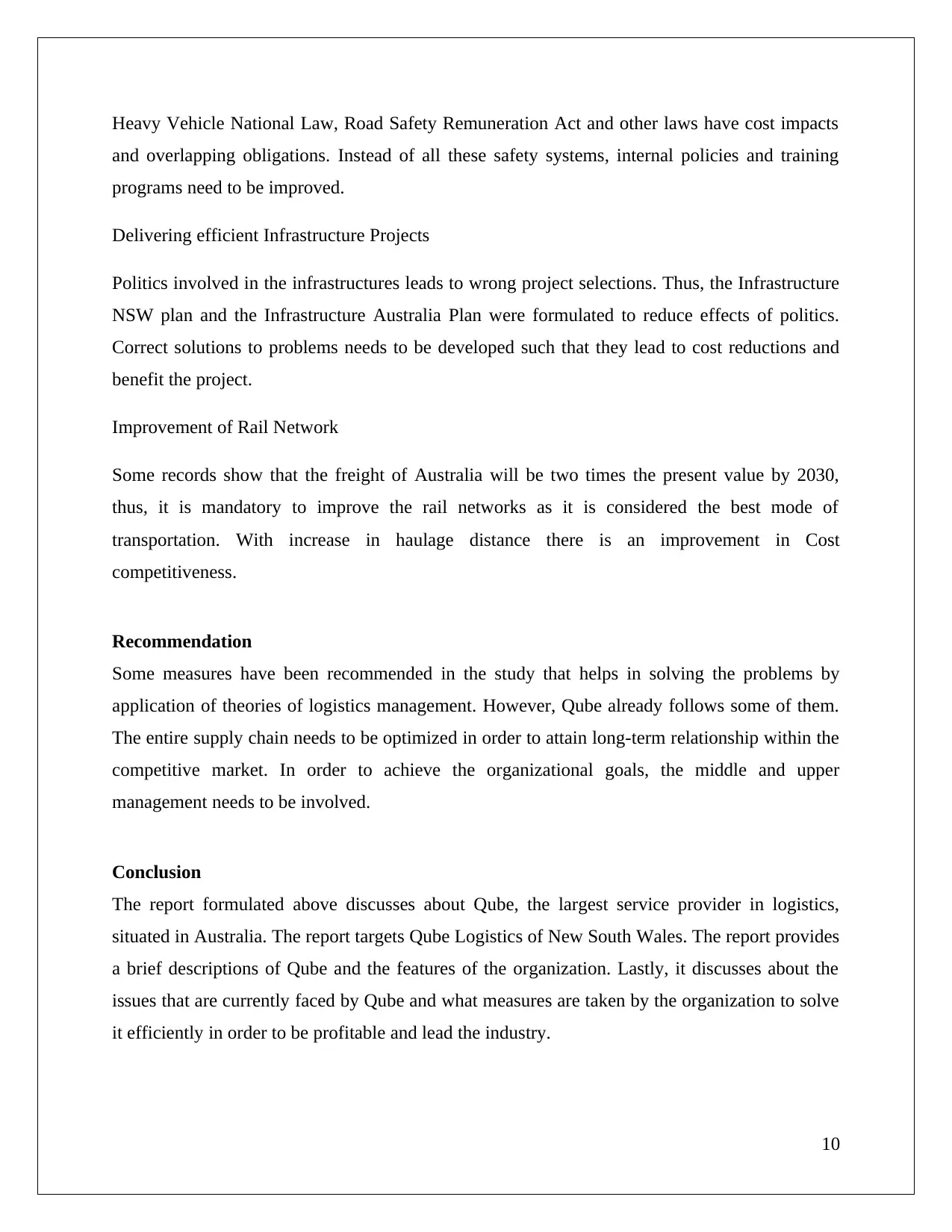
Heavy Vehicle National Law, Road Safety Remuneration Act and other laws have cost impacts
and overlapping obligations. Instead of all these safety systems, internal policies and training
programs need to be improved.
Delivering efficient Infrastructure Projects
Politics involved in the infrastructures leads to wrong project selections. Thus, the Infrastructure
NSW plan and the Infrastructure Australia Plan were formulated to reduce effects of politics.
Correct solutions to problems needs to be developed such that they lead to cost reductions and
benefit the project.
Improvement of Rail Network
Some records show that the freight of Australia will be two times the present value by 2030,
thus, it is mandatory to improve the rail networks as it is considered the best mode of
transportation. With increase in haulage distance there is an improvement in Cost
competitiveness.
Recommendation
Some measures have been recommended in the study that helps in solving the problems by
application of theories of logistics management. However, Qube already follows some of them.
The entire supply chain needs to be optimized in order to attain long-term relationship within the
competitive market. In order to achieve the organizational goals, the middle and upper
management needs to be involved.
Conclusion
The report formulated above discusses about Qube, the largest service provider in logistics,
situated in Australia. The report targets Qube Logistics of New South Wales. The report provides
a brief descriptions of Qube and the features of the organization. Lastly, it discusses about the
issues that are currently faced by Qube and what measures are taken by the organization to solve
it efficiently in order to be profitable and lead the industry.
10
and overlapping obligations. Instead of all these safety systems, internal policies and training
programs need to be improved.
Delivering efficient Infrastructure Projects
Politics involved in the infrastructures leads to wrong project selections. Thus, the Infrastructure
NSW plan and the Infrastructure Australia Plan were formulated to reduce effects of politics.
Correct solutions to problems needs to be developed such that they lead to cost reductions and
benefit the project.
Improvement of Rail Network
Some records show that the freight of Australia will be two times the present value by 2030,
thus, it is mandatory to improve the rail networks as it is considered the best mode of
transportation. With increase in haulage distance there is an improvement in Cost
competitiveness.
Recommendation
Some measures have been recommended in the study that helps in solving the problems by
application of theories of logistics management. However, Qube already follows some of them.
The entire supply chain needs to be optimized in order to attain long-term relationship within the
competitive market. In order to achieve the organizational goals, the middle and upper
management needs to be involved.
Conclusion
The report formulated above discusses about Qube, the largest service provider in logistics,
situated in Australia. The report targets Qube Logistics of New South Wales. The report provides
a brief descriptions of Qube and the features of the organization. Lastly, it discusses about the
issues that are currently faced by Qube and what measures are taken by the organization to solve
it efficiently in order to be profitable and lead the industry.
10
Paraphrase This Document
Need a fresh take? Get an instant paraphrase of this document with our AI Paraphraser
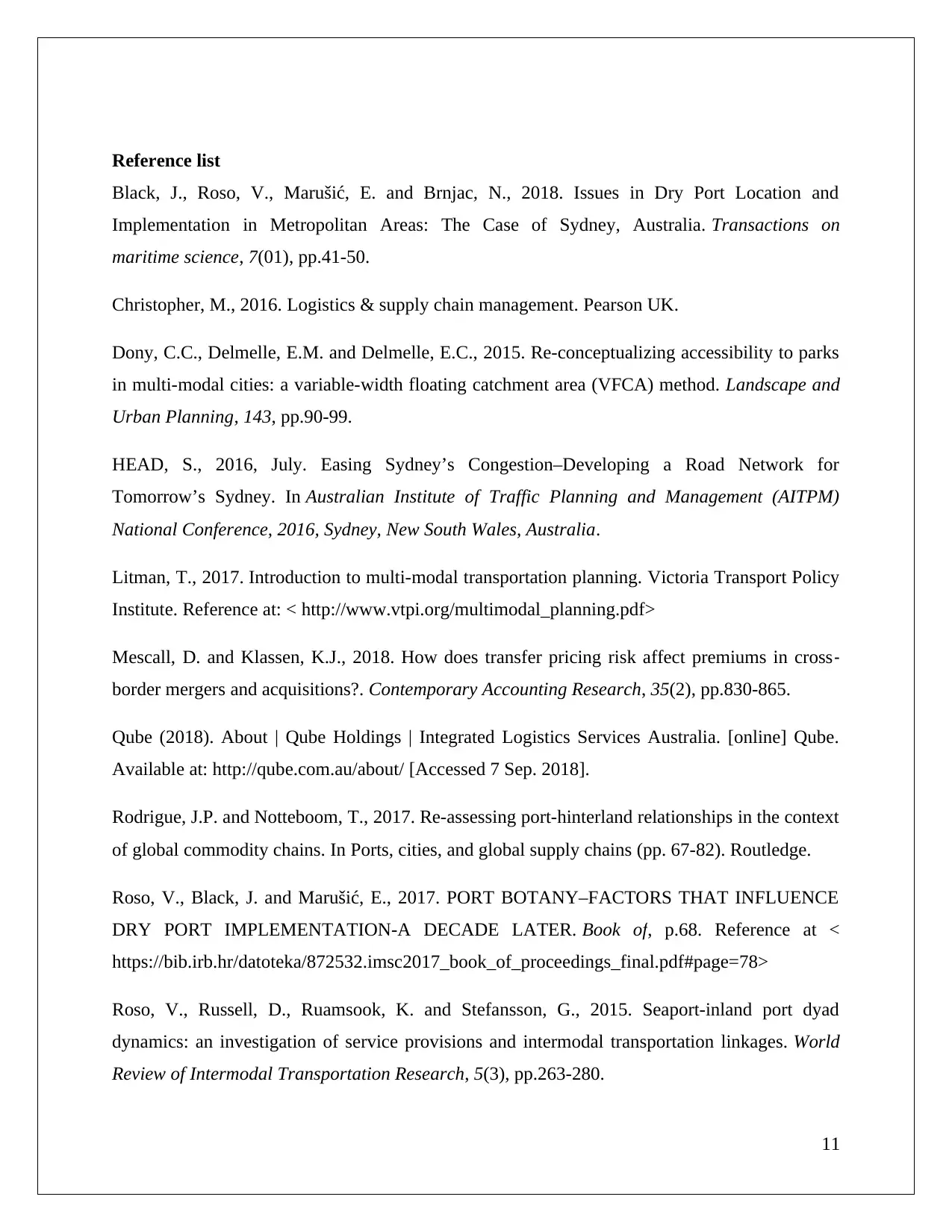
Reference list
Black, J., Roso, V., Marušić, E. and Brnjac, N., 2018. Issues in Dry Port Location and
Implementation in Metropolitan Areas: The Case of Sydney, Australia. Transactions on
maritime science, 7(01), pp.41-50.
Christopher, M., 2016. Logistics & supply chain management. Pearson UK.
Dony, C.C., Delmelle, E.M. and Delmelle, E.C., 2015. Re-conceptualizing accessibility to parks
in multi-modal cities: a variable-width floating catchment area (VFCA) method. Landscape and
Urban Planning, 143, pp.90-99.
HEAD, S., 2016, July. Easing Sydney’s Congestion–Developing a Road Network for
Tomorrow’s Sydney. In Australian Institute of Traffic Planning and Management (AITPM)
National Conference, 2016, Sydney, New South Wales, Australia.
Litman, T., 2017. Introduction to multi-modal transportation planning. Victoria Transport Policy
Institute. Reference at: < http://www.vtpi.org/multimodal_planning.pdf>
Mescall, D. and Klassen, K.J., 2018. How does transfer pricing risk affect premiums in cross‐
border mergers and acquisitions?. Contemporary Accounting Research, 35(2), pp.830-865.
Qube (2018). About | Qube Holdings | Integrated Logistics Services Australia. [online] Qube.
Available at: http://qube.com.au/about/ [Accessed 7 Sep. 2018].
Rodrigue, J.P. and Notteboom, T., 2017. Re-assessing port-hinterland relationships in the context
of global commodity chains. In Ports, cities, and global supply chains (pp. 67-82). Routledge.
Roso, V., Black, J. and Marušić, E., 2017. PORT BOTANY–FACTORS THAT INFLUENCE
DRY PORT IMPLEMENTATION-A DECADE LATER. Book of, p.68. Reference at <
https://bib.irb.hr/datoteka/872532.imsc2017_book_of_proceedings_final.pdf#page=78>
Roso, V., Russell, D., Ruamsook, K. and Stefansson, G., 2015. Seaport-inland port dyad
dynamics: an investigation of service provisions and intermodal transportation linkages. World
Review of Intermodal Transportation Research, 5(3), pp.263-280.
11
Black, J., Roso, V., Marušić, E. and Brnjac, N., 2018. Issues in Dry Port Location and
Implementation in Metropolitan Areas: The Case of Sydney, Australia. Transactions on
maritime science, 7(01), pp.41-50.
Christopher, M., 2016. Logistics & supply chain management. Pearson UK.
Dony, C.C., Delmelle, E.M. and Delmelle, E.C., 2015. Re-conceptualizing accessibility to parks
in multi-modal cities: a variable-width floating catchment area (VFCA) method. Landscape and
Urban Planning, 143, pp.90-99.
HEAD, S., 2016, July. Easing Sydney’s Congestion–Developing a Road Network for
Tomorrow’s Sydney. In Australian Institute of Traffic Planning and Management (AITPM)
National Conference, 2016, Sydney, New South Wales, Australia.
Litman, T., 2017. Introduction to multi-modal transportation planning. Victoria Transport Policy
Institute. Reference at: < http://www.vtpi.org/multimodal_planning.pdf>
Mescall, D. and Klassen, K.J., 2018. How does transfer pricing risk affect premiums in cross‐
border mergers and acquisitions?. Contemporary Accounting Research, 35(2), pp.830-865.
Qube (2018). About | Qube Holdings | Integrated Logistics Services Australia. [online] Qube.
Available at: http://qube.com.au/about/ [Accessed 7 Sep. 2018].
Rodrigue, J.P. and Notteboom, T., 2017. Re-assessing port-hinterland relationships in the context
of global commodity chains. In Ports, cities, and global supply chains (pp. 67-82). Routledge.
Roso, V., Black, J. and Marušić, E., 2017. PORT BOTANY–FACTORS THAT INFLUENCE
DRY PORT IMPLEMENTATION-A DECADE LATER. Book of, p.68. Reference at <
https://bib.irb.hr/datoteka/872532.imsc2017_book_of_proceedings_final.pdf#page=78>
Roso, V., Russell, D., Ruamsook, K. and Stefansson, G., 2015. Seaport-inland port dyad
dynamics: an investigation of service provisions and intermodal transportation linkages. World
Review of Intermodal Transportation Research, 5(3), pp.263-280.
11
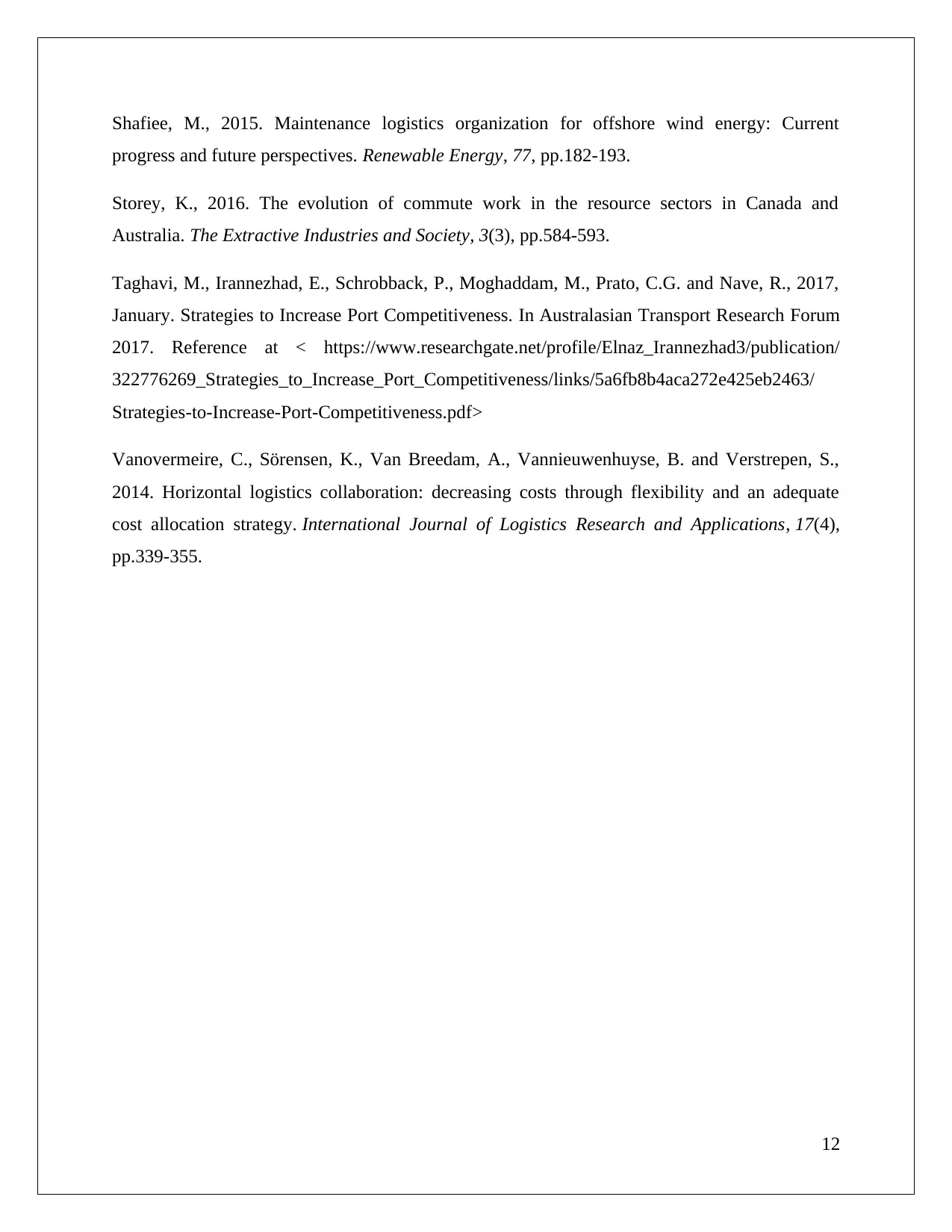
Shafiee, M., 2015. Maintenance logistics organization for offshore wind energy: Current
progress and future perspectives. Renewable Energy, 77, pp.182-193.
Storey, K., 2016. The evolution of commute work in the resource sectors in Canada and
Australia. The Extractive Industries and Society, 3(3), pp.584-593.
Taghavi, M., Irannezhad, E., Schrobback, P., Moghaddam, M., Prato, C.G. and Nave, R., 2017,
January. Strategies to Increase Port Competitiveness. In Australasian Transport Research Forum
2017. Reference at < https://www.researchgate.net/profile/Elnaz_Irannezhad3/publication/
322776269_Strategies_to_Increase_Port_Competitiveness/links/5a6fb8b4aca272e425eb2463/
Strategies-to-Increase-Port-Competitiveness.pdf>
Vanovermeire, C., Sörensen, K., Van Breedam, A., Vannieuwenhuyse, B. and Verstrepen, S.,
2014. Horizontal logistics collaboration: decreasing costs through flexibility and an adequate
cost allocation strategy. International Journal of Logistics Research and Applications, 17(4),
pp.339-355.
12
progress and future perspectives. Renewable Energy, 77, pp.182-193.
Storey, K., 2016. The evolution of commute work in the resource sectors in Canada and
Australia. The Extractive Industries and Society, 3(3), pp.584-593.
Taghavi, M., Irannezhad, E., Schrobback, P., Moghaddam, M., Prato, C.G. and Nave, R., 2017,
January. Strategies to Increase Port Competitiveness. In Australasian Transport Research Forum
2017. Reference at < https://www.researchgate.net/profile/Elnaz_Irannezhad3/publication/
322776269_Strategies_to_Increase_Port_Competitiveness/links/5a6fb8b4aca272e425eb2463/
Strategies-to-Increase-Port-Competitiveness.pdf>
Vanovermeire, C., Sörensen, K., Van Breedam, A., Vannieuwenhuyse, B. and Verstrepen, S.,
2014. Horizontal logistics collaboration: decreasing costs through flexibility and an adequate
cost allocation strategy. International Journal of Logistics Research and Applications, 17(4),
pp.339-355.
12
⊘ This is a preview!⊘
Do you want full access?
Subscribe today to unlock all pages.

Trusted by 1+ million students worldwide
1 out of 12
Related Documents
Your All-in-One AI-Powered Toolkit for Academic Success.
+13062052269
info@desklib.com
Available 24*7 on WhatsApp / Email
![[object Object]](/_next/static/media/star-bottom.7253800d.svg)
Unlock your academic potential
Copyright © 2020–2025 A2Z Services. All Rights Reserved. Developed and managed by ZUCOL.




